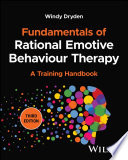(EBook PDF) Fundamentals of Rational Emotive Behaviour Therapy A Training Handbook 3rd Edition by Windy Dryden 1394198523 9781394198528 full chapters
$50.00 Original price was: $50.00.$25.00Current price is: $25.00.
Fundamentals of Rational Emotive Behaviour Therapy: A Training Handbook 3rd Edition by Windy Dryden – Ebook PDF Instant Download/DeliveryISBN: 1394198523, 9781394198528
Full download Fundamentals of Rational Emotive Behaviour Therapy: A Training Handbook 3rd Edition after payment

Product details:
ISBN-10 : 1394198523
ISBN-13 : 9781394198528
Author: Windy Dryden
Rational Emotive Behaviour Therapy (REBT) is a cognitive-behavioural approach to psychotherapy in which patients are taught to identify and reject irrational and damaging thought patterns and emotional responses. By emphasizing patients’ control over their mental and emotional lives, it cultivates honest self-assessment and healthy emotional responses. Since its development in the 1950s, it has stood as one of the most widely used and successful forms of cognitive- behavioural therapy.
Fundamentals of Rational Emotive Behaviour Therapy looks to cultivate a robust foundational understanding of this essential mode of treatment. Seeking to replicate the conditions and learning patterns of an introductory seminar, it emphasizes concrete clinical applications and a continuous connection between theory and practice. The third edition of this pathbreaking guide offers expanded coverage and fully up-to-date research.
Fundamentals of Rational Emotive Behaviour Therapy: A Training Handbook 3rd Table of contents:
CHAPTER ONE: What you need to know about the theory of REBT to get started
The situational ABC model of REBT
Situations
As
Bs
Flexible and non‐extreme attitudes
Rigid and extreme attitudes
Cs
ABCs interact in complex ways: the principle of psychological interactionism
Summary
CHAPTER TWO: What you need to know about the practice of REBT to get started
The ‘core conditions’
Therapeutic style
The goals of REBT
Tasks in REBT
CHAPTER THREE: Teaching the ABCs of REBT
The money model
Failure to clarify vague emotional statements, thus not distinguishing between HNEs and UNEs
Failure to emphasise the rigid and extreme components of the client’s rigid and extreme attitude in part two
Failure to summarise accurately all the points
Summary
The lateness example
Simpler ways of teaching the ABCs
CHAPTER FOUR: Distinguishing between healthy and unhealthy negative emotions
HNEs and UNEs: a diagrammatic summary
Five approaches to teaching clients the distinction between HNEs and UNEs
Teaching your client to distinguish between a UNE (unhealthy anger) and an HNE (healthy anger): an illustrative dialogue
CHAPTER FIVE: Being specific in the assessment process
Select a nominated problem
CHAPTER SIX: Assessing C
Avoid A → C language in assessing C
When your client believes that an HNE is unhealthy
When your client’s C is vague
When your client’s C is really an A
When your client’s C is an extended statement
CHAPTER SEVEN: Assessing A
Identify the theme and its embodiment
The ‘magic question’
CHAPTER EIGHT: Assessing B
The two‐step approach to assessing attitudes
Windy’s review assessment procedure (WRAP)
CHAPTER NINE: Assessing meta‐emotional problems
The ABCs of meta‐emotional problems
When the meta‐emotional problem is the major focus
CHAPTER TEN: Goal‐setting
Setting a goal with respect to a specific example of your client’s nominated problem
Setting a goal with respect to your client’s broad problem
Moving from overcoming disturbance to promoting personal development
CHAPTER ELEVEN: Eliciting your client’s commitment to change
Introduction
The cost–benefit analysis form (CBAF)
CHAPTER TWELVE: Preparing your client and yourself to examine their attitudes
Helping your client to see the relevance of examining their attitudes as a primary means of achieving their goal
Helping your client to understand what examining attitudes involves
How many of the four rigid/extreme attitudes and their flexible/non‐extreme attitudes should you and your client examine?
CHAPTER THIRTEEN: Helping your clients to examine their attitudes
The three main arguments
The choice‐based examination method
Use persuasive arguments in the examination process
Dealing with clients’ doubts, reservations and objections to developing flexible and non‐extreme attitudes and letting go of rigid and extreme attitudes
CHAPTER FOURTEEN: Helping your clients to strengthen their conviction in their flexible/non‐extreme attitudes
Using zigzag techniques with clients
Using rational‐emotive imagery with clients
Suggest that your clients teach flexible/non‐extreme attitudes to others1
Taking action
CHAPTER FIFTEEN: Negotiating homework assignments
What’s in a name?
Discussing the purpose of homework assignments
Different types of homework assignments
The importance of negotiating homework assignments
The ‘challenging, but not overwhelming’ principle of homework negotiation
How to increase the chances that your client will do homework
Monitor your skills at negotiating homework assignments
CHAPTER SIXTEEN: Reviewing homeworkassignments
Put reviewing your client’s homework assignment on the session agenda
When is it best to review homework assignments?
Important issues to consider when reviewing homework assignments
CHAPTER SEVENTEEN: Dealing with your clients’ misconceptions of REBT theory and practice
CHAPTER EIGHTEEN: Using REBT in a single‐session therapy format
Introduction
Many clients want immediate help
Albert Ellis’s approach to the first session
Key principles of the SST mindset
The importance of informed consent
The practice of REBT in a single‐session format
Bring the session to a close and agree access for further help if requested
CHAPTER NINETEEN: An example of an REBT‐based single session
Commentary
People also search for Fundamentals of Rational Emotive Behaviour Therapy: A Training Handbook 3rd:
the decline of western civilization
decline of western civilization 2
decline of western civilization 3
history of western civilization
cradle of western civilization
Tags:
Fundamentals,Rational Emotive,Behaviour Therapy,Training Handbook,Windy Dryden
You may also like…
Chemistry - Analytical Chemistry
Fundamentals of Analytical Chemistry 3rd Edition By Douglas A. Skoog
Uncategorized
Uncategorized
Uncategorized
Uncategorized
Uncategorized












